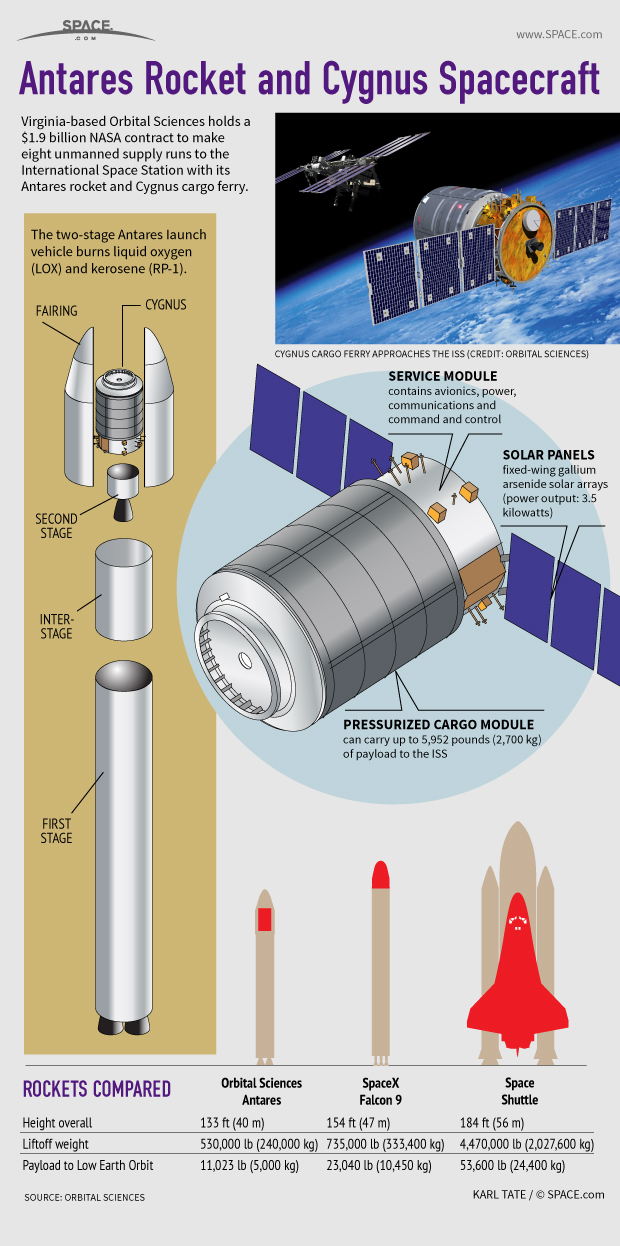Orbital ATK Will Try to Launch Antares Rocket Tonight: Watch It Live

Update for Oct. 17 at 8:30 p.m. EDT: Orbital ATK's upgraded Antares rocket has successfully launched its Cygnus cargo ship into orbit. Read the full story: Orbital ATK's Antares Rocket Returns to Flight with Gorgeous Night Cargo Launch
WALLOPS ISLAND, Va. — The commercial spaceflight company Orbital ATK is once again counting down to the launch an Antares rocket from Virginia's Eastern Shore tonight (Oct. 17). You can watch the launch live online — and possibly even see it with your own eyes if you live along the U.S. East Coast.
The Antares rocket is slated to launch an unmanned Cygnus cargo ship toward the International Space Station (ISS) at 7:40 p.m. EDT (2340 GMT) from Pad-0A at NASA's Wallops Flight Facility here on Wallops Island. A launch attempt on Sunday was scrubbed due to a glitch in a ground-support cable, but the Antares rocket itself and its Cygnus payload are in good health, Keith Koehler, a NASA communications officer at Wallops Flight Facility, wrote in a statement. You can watch a webcast of the launch here beginning at about 6 p.m. EDT (2200 GMT), courtesy of NASA TV.
Tonight, Antares will be visible to millions of viewers in the eastern U.S. as the rocket soars toward the southeast. Visibility depends on local weather conditions, but the evening sky will provide a nice, dark backdrop for the rocket's glowing exhaust flames. [Viewing Guide: How to See the Nighttime Antares Rocket Launch]

The uncrewed flight comes nearly two years after Orbital ATK's last Antares rocket exploded over the same launchpad just seconds after liftoff. After rebuilding Pad-0A and designing a new version of the rocket, called Antares 230, Orbital ATK is confident that tonight's launch will go smoothly, officials said on Saturday (Oct. 15). According to a NASA update today, there is a 95-percent chance of good launch weather for tonight's planned liftoff.
Antares will carry an Orbital ATK-built Cygnus spacecraft with 5,100 lbs. (2,300 kilograms) of cargo onboard to the ISS. Cygnus will separate from Antares roughly 9 minutes after liftoff and begin to raise its orbit to reach the space station. The spacecraft will have to wait until after Friday (Oct. 21) to be attached to the space station. That's because a Russian Soyuz spacecraft carrying three new crewmembers for the station is due to arrive early Friday morning after itself launching into space on Wednesday (Oct. 19).
Cygnus will stay docked at the space station until November, when the spacecraft will depart with a load of waste items. The spacecraft will ultimately plunge back into Earth's atmosphere to be intentionally burned up, ending its mission.
Breaking space news, the latest updates on rocket launches, skywatching events and more!
Editor's note: If you capture an amazing photo of the Antares launch and would like to share it Space.com for a story or gallery, send comments and images in to spacephotos@space.com.
Email Hanneke Weitering at hweitering@space.com or follow her @hannekescience. Follow us @Spacedotcom, Facebook and Google+. Original article on Space.com.
Join our Space Forums to keep talking space on the latest missions, night sky and more! And if you have a news tip, correction or comment, let us know at: community@space.com.

Hanneke Weitering is a multimedia journalist in the Pacific Northwest reporting on the future of aviation at FutureFlight.aero and Aviation International News and was previously the Editor for Spaceflight and Astronomy news here at Space.com. As an editor with over 10 years of experience in science journalism she has previously written for Scholastic Classroom Magazines, MedPage Today and The Joint Institute for Computational Sciences at Oak Ridge National Laboratory. After studying physics at the University of Tennessee in her hometown of Knoxville, she earned her graduate degree in Science, Health and Environmental Reporting (SHERP) from New York University. Hanneke joined the Space.com team in 2016 as a staff writer and producer, covering topics including spaceflight and astronomy. She currently lives in Seattle, home of the Space Needle, with her cat and two snakes. In her spare time, Hanneke enjoys exploring the Rocky Mountains, basking in nature and looking for dark skies to gaze at the cosmos.
